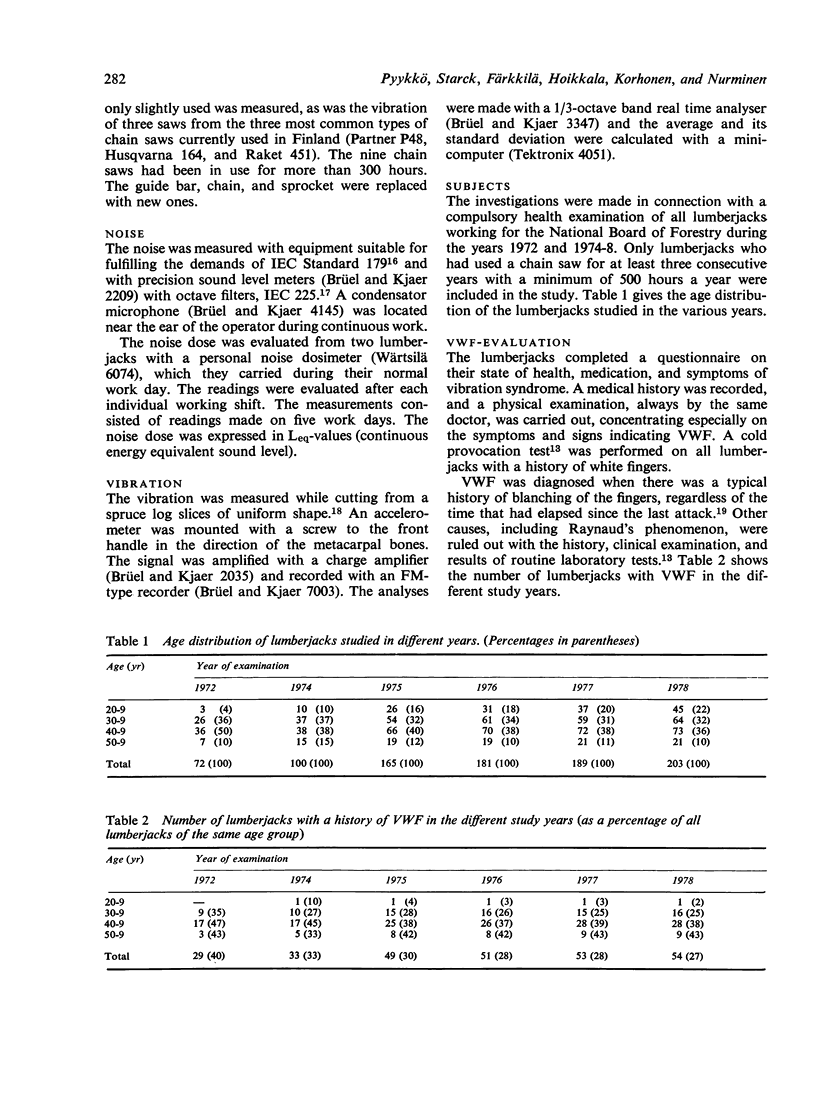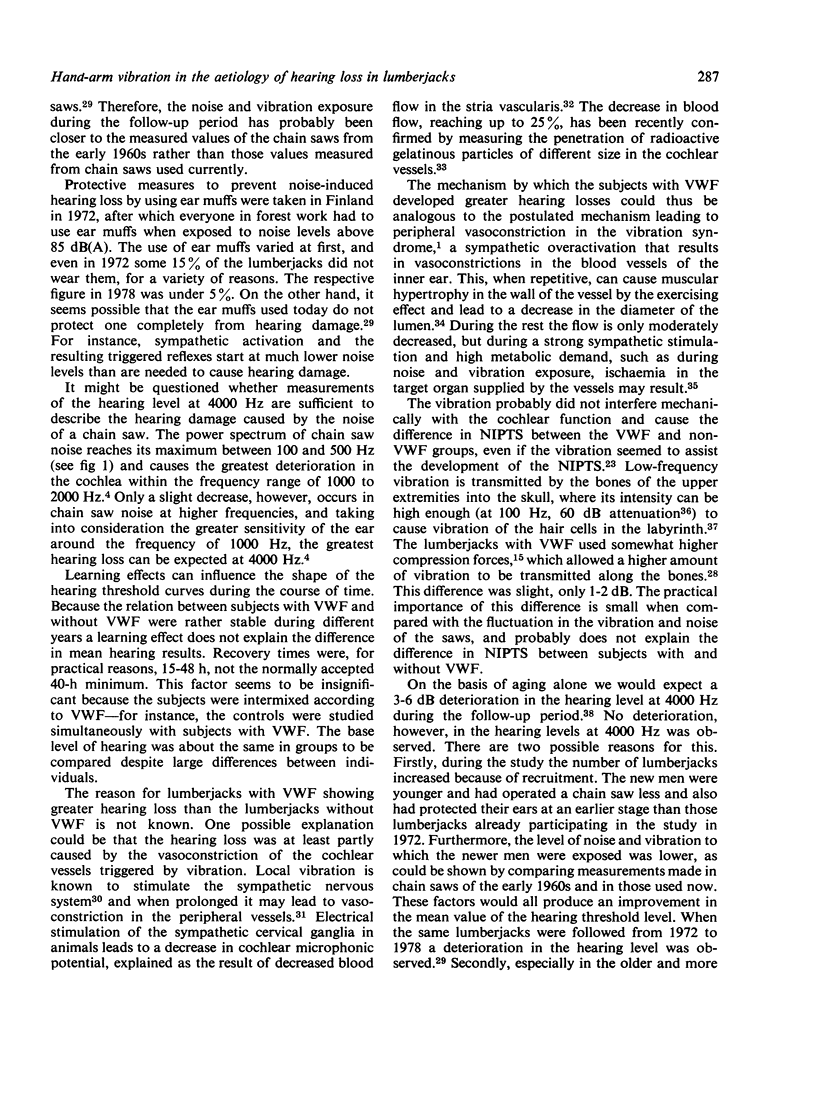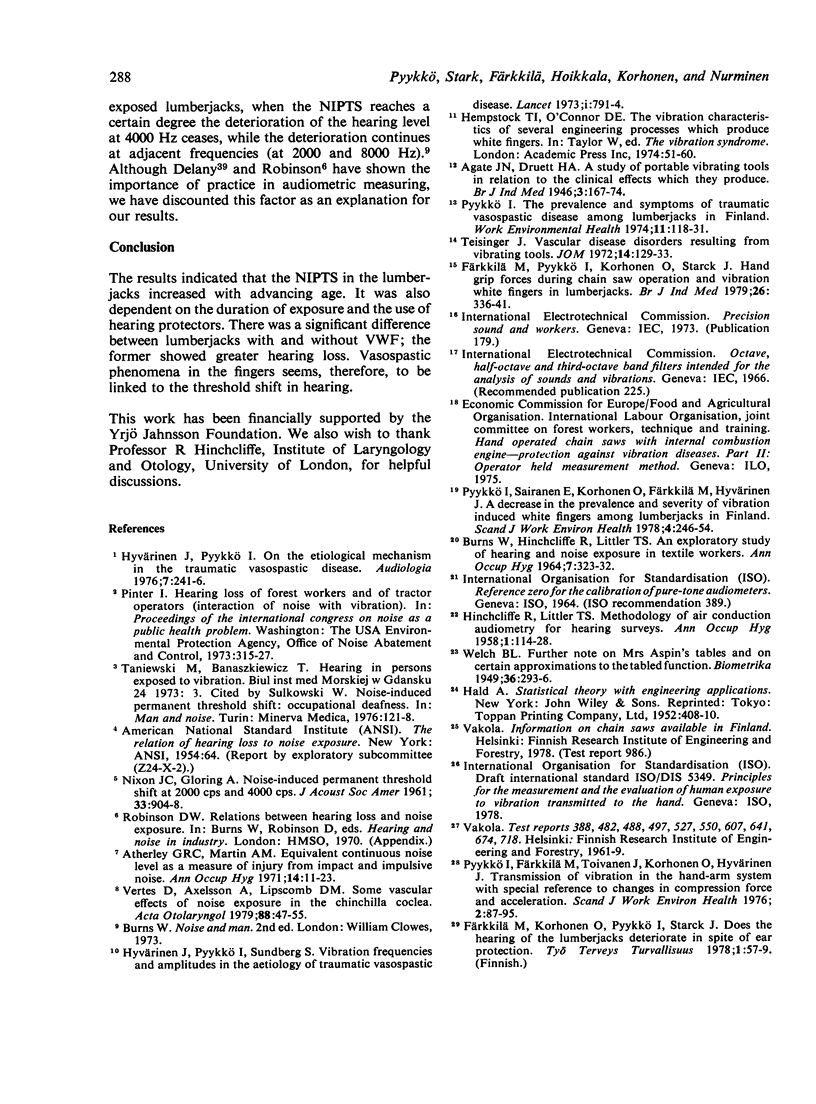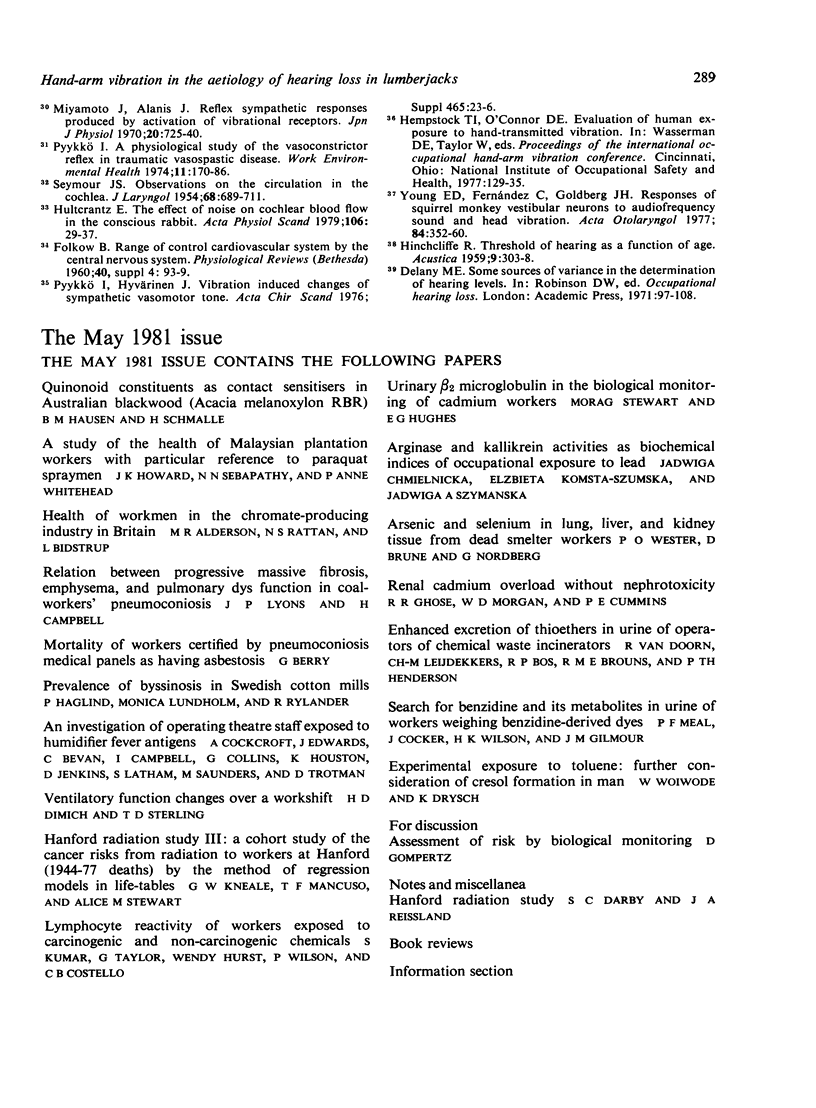Abstract
A longitudinal study of hearing loss was conducted among a group of lumberjacks in the years 1972 and 1974--8. The number of subjects increased from 72 in 1972 to 203 in 1978. They were classified according to (1) a history of vibration-induced white finger (VWF), (2) age, (3) duration of exposure, an (4) duration of ear muff usage. The hearing level at 4000 Hz was used to indicate the noise-induced permanent threshold shift (NIPTS). The lumberjacks were exposed, at their present pace of work, to noise, Leq values 96-103 dB(A), and to the vibration of a chain saw (linear acceleration 30-70 ms-2). The chain saws of the early 1960s were more hazardous, with the average noise level of 111 dB(A) and a variation acceleration of 60-180 ms-2. When classified on the basis of age, the lumberjacks with VWF had about a 10 dB greater NIPTS than subjects without VWF. NIPTS increased with the duration of exposure to chain saw noise, but with equal noise exposure the NIPTS was about 10 dB greater in lumberjacks with VWF than without VWF. With the same duration of ear protection the lumberjacks with VWF consistently had about a 10 dB greater NIPTS than those without VWF. The differences in NIPTS were statistically significant. The possible reason for more advanced NIPTS in subjects with VWF is that vibration might operate in both of these disorders through a common mechanism--that is, producing a vasoconstriction in both cochlear and digital blood vessels as a result of sympathetic nervous system activity.
Full text
PDF








Selected References
These references are in PubMed. This may not be the complete list of references from this article.
- Atherley G. R., Martin A. M. Equivalent-continuous noise level as a measure of injury from impact and impulse noise. Ann Occup Hyg. 1971 Mar;14(1):11–23. doi: 10.1093/annhyg/14.1.11. [DOI] [PubMed] [Google Scholar]
- BURNS W., HINCHCLIFFE R., LITTLER T. S. AN EXPLORATORY STUDY OF HEARING AND NOISE EXPOSURE IN TEXTILE WORKERS. Ann Occup Hyg. 1964 Dec;7:323–333. doi: 10.1093/annhyg/7.4.323. [DOI] [PubMed] [Google Scholar]
- Färkkilä M., Pyykkö I., Korhonen O., Starck J. Hand grip forces during chain saw operation and vibration white finger in lumberjacks. Br J Ind Med. 1979 Nov;36(4):336–341. doi: 10.1136/oem.36.4.336. [DOI] [PMC free article] [PubMed] [Google Scholar]
- Hultcrantz E. The effect of noise on cochlear blood flow in the conscious rabbit. Acta Physiol Scand. 1979 May;106(1):29–37. doi: 10.1111/j.1748-1716.1979.tb06366.x. [DOI] [PubMed] [Google Scholar]
- Hyvärinen J., Pyykkö I., Sundberg S. Vibration frequencies and amplitudes in the aetiology of traumatic vasospastic disease. Lancet. 1973 Apr 14;1(7807):791–794. doi: 10.1016/s0140-6736(73)90598-9. [DOI] [PubMed] [Google Scholar]
- Miyamoto J., Alanís J. Reflex sympathetic responses produced by activation of vibrational receptors. Jpn J Physiol. 1970 Dec 15;20(6):725–740. doi: 10.2170/jjphysiol.20.725. [DOI] [PubMed] [Google Scholar]
- Pyykko I., Sairanen E., Korhonen O., Fărkkilă M., Hyvărinen J. A decrease in the prevalence and severity of vibration-induced white fingers among lumberjacks in Finland. Scand J Work Environ Health. 1978 Sep;4(3):246–254. doi: 10.5271/sjweh.2701. [DOI] [PubMed] [Google Scholar]
- Pyykkö I., Färkkilä M., Toivanen J., Korhonen O., Hyvärinen J. Transmission of vibration in the hand-arm system with special reference to changes in compression force and acceleration. Scand J Work Environ Health. 1976 Jun;2(2):87–95. doi: 10.5271/sjweh.2820. [DOI] [PubMed] [Google Scholar]
- Pyykkö I. The prevalence and symptoms of traumatic vasospastic disease among lumberjacks in Finland. A field study. Work Environ Health. 1974;11(2):118–131. [PubMed] [Google Scholar]
- SEYMOUR J. C. Observations on the circulation in the cochlea. J Laryngol Otol. 1954 Oct;68(10):689–711. doi: 10.1017/s0022215100050131. [DOI] [PubMed] [Google Scholar]
- Teisinger J. Vascular disease disorders resulting from vibrating tools. J Occup Med. 1972 Feb;14(2):129–133. [PubMed] [Google Scholar]
- Vertes D., Axelsson A., Lipscomb D. M. Some vascular effects of noise exposure in the chinchilla cochlea. Acta Otolaryngol. 1979;88(1-2):47–55. doi: 10.3109/00016487909137139. [DOI] [PubMed] [Google Scholar]
- Young E. D., Fernández C., Goldberg J. M. Responses of squirrel monkey vestibular neurons to audio-frequency sound and head vibration. Acta Otolaryngol. 1977 Nov-Dec;84(5-6):352–360. doi: 10.3109/00016487709123977. [DOI] [PubMed] [Google Scholar]


